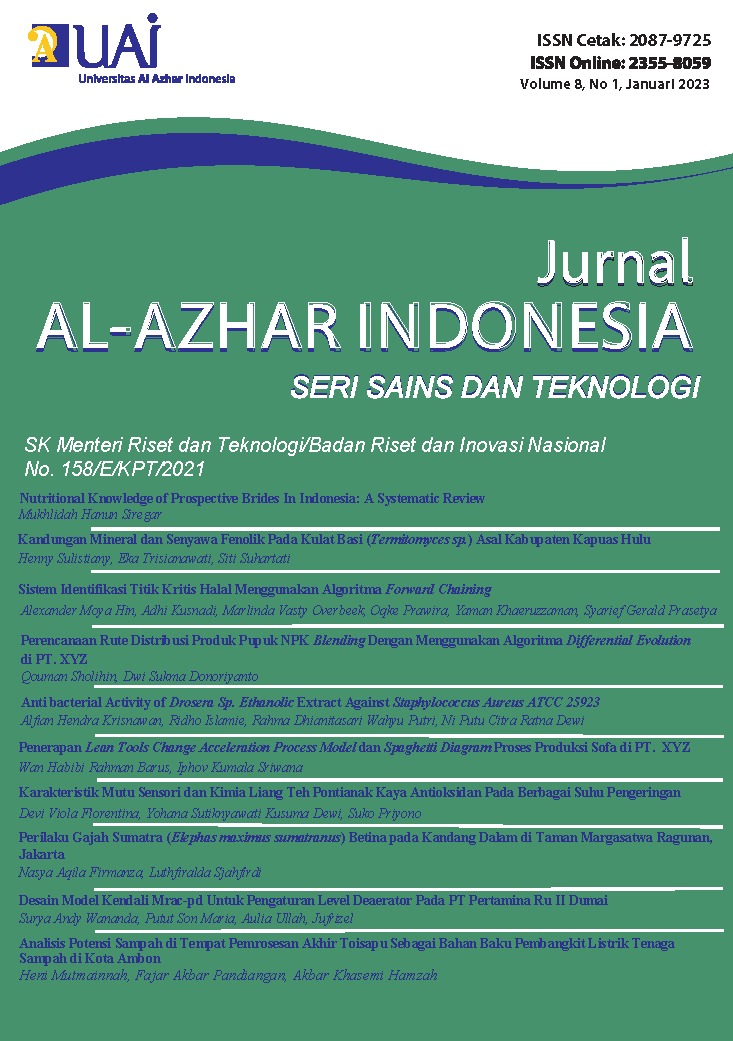Sistem Identifikasi Titik Kritis Halal Menggunakan Algoritma Forward Chaining
DOI:
https://doi.org/10.36722/sst.v8i1.1285Abstract
Halal products are obligatory to be used by people who are Muslim. When viewed in terms of the number of the Muslim population in the world and Indonesia, halal products have very potential economic opportunities. However, halal products have the risk of becoming non-halal if the accompanying process and storage do not follow halal rules. Therefore, it is necessary to identify the critical halal point, the point where the potential for such change occurs. So far, identification is made manually, of course there will be opportunities for identification errors to happen and it will take a relatively long time. To overcome these problems, identification can use a computer-based system. Forward chaining is an algorithm that is suitable for identifying halal points, because in SJH LPPOM MUI there is a decision tree for identifying halal critical points which is carried out in the same forward sequence as the forward chaining algorithm process flow. The development of a halal critical point identification system is carried out using the Software Development Life Cycle V-model method, the PHP programming language and the MySQL Database Management System. The system was successfully tested using Whitebox testing, including unit testing, integration testing, and overall system testing. Then testing using Blackbox testing techniques by comparing the results of identifying critical points using the system with the results of identifying critical points manually producing the same results. User satisfaction testing was also carried out using the End User Computing Satisfaction method and obtained an average satisfaction score of 86.53%
Keywords – halal products, critical halal point, AI, forward chaining
References
V. B. Kusnandar, “RISSC: Populasi Muslim Indonesia Terbesar di Dunia | Databoks,†databoks, Nov. 03, 2021. https://databoks.katadata.co.id/datapublish/2021/11/03/rissc-populasi-muslim-indonesia-terbesar-di-dunia (accessed Jul. 15, 2022).
Komite Nasional Keuangan Syariah, “Masterplan Ekonomi Syariah Indonesia 2019-2024,†2018. [Online]. Available: https://knks.go.id/storage/upload/1573459280-Masterplan Eksyar_Preview.pdf.
G. Rahmadani, “Halal dan Haram dalam Islam,†J. Ilm. Penegakan Huk., vol. 2, no. 1, pp. 20–26, 2015.
S. A. Estikomah, “Pemanfaatan Rhizopus Oryzae Dalam Pengembangan Produk Olahan Susu (Keju) Halal Berbasis Bioteknologi,†Pharm. J. Islam. Pharm., vol. 4, no. 2, pp. 34–38, 2020.
Y. Atma, M. Taufik, and H. Seftiono, “Identifikasi resiko titik kritis kehalalan produk pangan: studi produk bioteknologi,†J. Teknol., vol. 10, no. 1, pp. 59–66, 2018.
A. Faridah, “Identifikasi Titik Kritis Kehalalan Pangan di Rumah Makan Ampalu Raya Padang,†J. Kapita Sel. Geogr., vol. 2, no. 10, pp. 16–25, 2019.
D. Triagus and S. Khairunnisa, “Analysis of Halal and Safety Assurance Cost in Mie Jogja Pak Karso Restaurant,†J. Teknol. Pertan., vol. 17, no. 2, pp. 105–118, 2016.
R. F. Dewi, “Penerapan Sistem Jaminan Halal (SJH) Dalam Memperoleh Sertifikat Halal Di Rumah Pemotongan Hewan Unggas (RPH-U)(Studi Kasus RPH-U Mitra Karya Unggas Batu–Jawa Timur.†Universitas Brawijaya, 2015.
S. Endang, A. Jumiono, and S. Akil, “IDENTIFIKASI TITIK KRITIS KEHALALAN GELATIN,†J. Ilm. PANGAN HALAL, vol. 2, no. 1, pp. 17–22, 2020.
D. Amanah, S. Wasiyanti, and L. Widiastuti, “Perbandingan Pencatatan Akuntansi Manual Dengan Menggunakan Aplikasi Berbasis Komputer Pada Depok Street Market,†JAIS-Journal Account. Inf. Syst., vol. 1, no. 02, 2021.
A. Al-Ajlan, “The comparison between forward and backward chaining,†Int. J. Mach. Learn. Comput., vol. 5, no. 2, p. 106, 2015.
K. R. Chowdhary, “Rule Based Reasoning,†in Fundamentals of Artificial Intelligence, Springer, 2020, pp. 89–109.
MUI, Panduan Umum Sistem Jaminan Halal LPPOM–MUI. 2008.
S. Balaji and M. S. Murugaiyan, “Waterfall vs. V-Model vs. Agile: A comparative study on SDLC,†Int. J. Inf. Technol. Bus. Manag., vol. 2, no. 1, pp. 26–30, 2012.
P. D. Sugiyono, “Metode Penelitian dan Pengembangan (research and Developement/R&D)(MS Sofia Yustiyani Suryandari, SE (ed.).†CV. Alfabebta, 2015.

